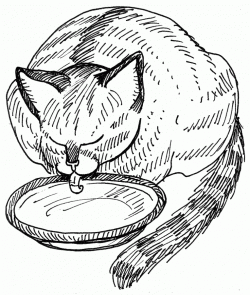Suck it up: How cats' tongues work magic
Q. Who's the "smarter" drinker in your household, Fido or Felix? –J. Fariello
A. Your cat's famous milk-lapping tongue manages an elegant interplay between the liquid's inertia and gravity that goes way beyond your dog's more rudimentary ladling approach, says Susan Milius in Science News magazine. A dog drinks basically by forming its tongue into a little cup that scoops up liquid, says Pedro Reis of the Massachusetts Institute of Technology.
"Cats are much more sophisticated in their knowledge of fluid dynamics," he deadpans.
Unlike people and pigs and sheep, cats and most other adult carnivores lack the cheeks for sucking in a liquid; instead, a cat plunges its tongue to the bottom of a shallow bowl and licks off the liquid. But the motion known as "lapping" works quite differently, with the cat thrusting its tongue down in a J-shape and the tip curling under to touch the surface. Liquid adheres to the tip and the tongue pulls it back into the mouth at peak speed, maximizing the amount ingested, the same for a lion as for a tabby cat.
Q. You sit at the party admiring the woman's stunning outfit, the young man's great physique, and the older gentleman's melodious voice when a guy comes up and asks why you walked past him the other day without saying anything. This embarrassing experience reminds you of a college date at a restaurant; upon returning from the restroom, you sat down at the wrong booth, facing the wrong man! You remained unaware even as your own date (seeming a stranger to you) accosted the wrong-booth guy and then stormed out. Nor are you any good at distinguishing actors in movies or on TV, and you often don't even recognize yourself in photos or videos. And just the other day, you failed to pick out your husband at the market. What’s wrong with you? –A. Alzheimer
A. These are experiences of writer Heather Sellers in her memoir Face First and of other victims of lifelong "prosopagnosia," or "face blindness," says David G. Myers in Psychology. While Sellers has excellent vision, she cannot recognize faces, a perception problem traced to the underside of her brain's right hemisphere. Perhaps the only upside to this is that when she encounters someone who previously irritated her, Sellers typically won't feel ill will because she doesn't even recognize the person. While most of us can recognize thousands of faces almost instantaneously, her experience is "much like the struggle you or I would have trying to recognize a specific penguin in a group of waddling penguins," she says.
Q. Where does the "k" in $50k come from? What if your $50k annual salary depended on your correct answer? –B. Bernanke
A. The "k" is for thousand-dollar increments, from the scientific abbreviation for "kilo" (kilometer, kilogram, kilobyte, etc.). It's a derivative of the Greek word "khiloi," meaning "one thousand," says David Hoffman in Little-Known Facts About Well-Known Stuff.
Q. What's the brainy bottom line for solving the Rubik's Cube? –R. Soulia
A. Since its invention in 1974, the Cube has taunted mathematicians trying to figure the maximum number of moves needed to solve it from any of its 43,252,003,274,489,856,000 possible starting positions, says Bruno Maddox in Discover magazine. In 2010, a team of whizzes "laid bare the uplifting truth": As hopelessly scrambled as Rubik's Cube may appear, one is never more than 20 moves from rendering each of its six faces a solid color. "We were secretly hoping in our tests that there would be one that required 21," said Kent State University mathematician and team member Morley Davidson, but it was not to be.
~
Send Strange questions to brothers Bill and Rich at
